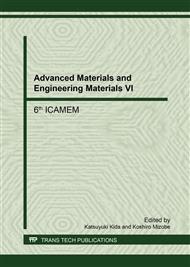[1]
N.W.M. Zulkifli et al., Lubricity of bio-based lubricant derived from different chemically modified fatty acid methyl ester,. Tribology International, 93 (2016) 555-562.
DOI: 10.1016/j.triboint.2015.03.024
Google Scholar
[2]
S. Arumugam, and G. Sriram, Synthesis and characterization of rapeseed oil bio-lubricant dispersed with nano copper oxide: Its effect on wear and frictional behavior of piston ring–cylinder liner combination,. Proceedings of the Institution of Mechanical Engineers, Part J: Journal of Engineering Tribology. 228(11) (2014).
DOI: 10.1177/1350650114535384
Google Scholar
[3]
M.V. Thottackkad, R.K. Perikinalil, and P.N. Kumarapillai, Experimental evaluation on the tribological properties of coconut oil by the addition of CuO nanoparticles,. International Journal of Precision Engineering and Manufacturing, 13(1) (2012).
DOI: 10.1007/s12541-012-0015-5
Google Scholar
[4]
S. Arumugam, G. Sriram, and R. Ellappan, Bio-lubricant-biodiesel combination of rapeseed oil: An experimental investigation on engine oil tribology, performance, and emissions of variable compression engine, Energy, 72 (2014) 618-627.
DOI: 10.1016/j.energy.2014.05.087
Google Scholar
[5]
S.M. Alves et al., Tribological behavior of vegetable oil-based lubricants with nanoparticles of oxides in boundary lubrication conditions,. Tribology International, 65 (2013) 28-36.
DOI: 10.1016/j.triboint.2013.03.027
Google Scholar
[6]
P. Nallasamy et al., Tribological investigations on MoS2-based nanolubricant for machine tool slideways,. Proceedings of the Institution of Mechanical Engineers, Part J: Journal of Engineering Tribology, 229(5) (2014), 559-567.
DOI: 10.1177/1350650114556394
Google Scholar
[7]
N.G. Demas et al., Tribological effects of BN and MoS2 nanoparticles added to polyalphaolefin oil in piston skirt/cylinder liner tests,. Tribology Letters, 47(1) (2012) 91-102.
DOI: 10.1007/s11249-012-9965-0
Google Scholar
[8]
B. Gullac, and O. Akalin, Frictional characteristics of IF-WS2 nanoparticles in simulated engine conditions,. Tribology Transactions, 53(6) (2010) 939-947.
DOI: 10.1080/10402004.2010.511761
Google Scholar
[9]
J. Padgurskas et al., Tribological properties of lubricant additives of Fe, Cu and Co nanoparticles,. Tribology International, 60(0) (2013) 224-232.
DOI: 10.1016/j.triboint.2012.10.024
Google Scholar
[10]
M. Gulzar et al. AW/EP behavior of WS2 nanoparticles added to vegetable oil-based lubricant,. pp.194-195, Proceedings of Malaysian International Tribology Conference (2015).
Google Scholar
[11]
N.W.M. Zulkifli et al., Wear prevention characteristics of a palm oil-based TMP (trimethylolpropane) ester as an engine lubricant,. Energy 54 (2013) 167-173.
DOI: 10.1016/j.energy.2013.01.038
Google Scholar
[12]
Y Choi, C Lee, Y Hwang, M Park, J Lee, C Choi et al. Tribological behavior of copper nanoparticles as additives in oil,. Current Applied Physics. 9 (2009) 124-127.
DOI: 10.1016/j.cap.2008.12.050
Google Scholar
[13]
J Zhou, Z Wu, Z Zhang, W Liu, Q Xue. Tribological behavior and lubricating mechanism of Cu nanoparticles in oil,. Tribology Letters. 8 (2000) 213-218.
Google Scholar


